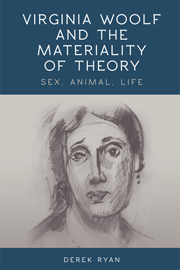Book contents
- Frontmatter
- Contents
- Acknowledgements
- Abbreviations
- Introduction: Virginia Woolf and the Materiality of Theory
- 1 Materials for Theory: Digging Granite and Chasing Rainbows
- 2 Sexual Difference in Becoming: A Room of One's Own and To the Lighthouse
- 3 Queering Orlando and Non/Human Desire
- 4 The Question of the Animal in Flush
- 5 Quantum Reality and Posthuman Life: The Waves
- Bibilography
- Index
Introduction: Virginia Woolf and the Materiality of Theory
Published online by Cambridge University Press: 05 September 2013
- Frontmatter
- Contents
- Acknowledgements
- Abbreviations
- Introduction: Virginia Woolf and the Materiality of Theory
- 1 Materials for Theory: Digging Granite and Chasing Rainbows
- 2 Sexual Difference in Becoming: A Room of One's Own and To the Lighthouse
- 3 Queering Orlando and Non/Human Desire
- 4 The Question of the Animal in Flush
- 5 Quantum Reality and Posthuman Life: The Waves
- Bibilography
- Index
Summary
I reach what I might call a philosophy; at any rate it is a constant idea of mine; that behind the cotton wool is hidden a pattern; that we – I mean all human beings – are connected with this; that the whole world is a work of art; that we are parts of the work of art. Hamlet or a Beethoven quartet is the truth about this vast mass that we call the world. But there is no Shakespeare, there is no Beethoven; certainly and emphatically there is no God; we are the words; we are the music; we are the thing itself. (MB 85)
When Virginia Woolf, in this famous passage from her unfinished and posthumously published memoir ‘Sketch of the Past’ (1976), outlines her ‘philosophy’ or ‘constant idea’, she presents us with a ‘conception’ of life that is embedded in materiality: a ‘pattern’, ‘hidden behind the cotton wool of daily life’ (MB 85). It is, as Mark Hussey has recently put it, a form of theorising that is ‘grounded’ and ‘embodied’, and other critics have placed emphasis on Woolf's formulation of human communality through language and art: Lorraine Sim, for example, writes of ‘a connective principle’ in Woolf's ‘pattern’ which is revealed through art and society; Emily Hinnov claims, more explicitly, that ‘Woolf views aesthetics as a vehicle for social action that might bring about humanistic unity […].
Information
- Type
- Chapter
- Information
- Virginia Woolf and the Materiality of TheorySex, Animal, Life, pp. 1 - 25Publisher: Edinburgh University PressPrint publication year: 2013
